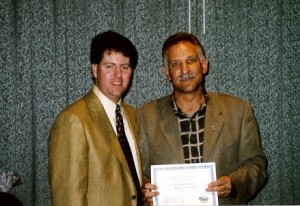September 2014, Vol. 69, No. 9
Features
NASSCO Standard Bearers

EDITOR’S NOTE: In 2016, NASSCO will celebrate its 40th year of setting standards for the assessment and rehabilitation of underground infrastructure. As we look forward, we also look back to those who have made significant contributions and have impacted the continued acceptance and use of trenchless technologies.
This month’s story features Mike Hogan, president of Duke’s Root Control. He has been a dedicated NASSCO member since 1988, working tirelessly for the trenchless industry. He served for many years on NASSCO’S Board of Directors, and as NASSCO’s President in 2002. He has also served on the Board of Directors for NASTT, has chaired a variety of NASSCO Committees (including scholarships and awards, as well as industry standards) and was inducted into NASSCO’s Sanitary Sewer Sleuth Society in 2009. This is the third installment in a series of articles exploring the history of NASSCO through the eyes of industry leaders:
I started my career in 1984 on the procurement and inventory control side of business for a large national construction company. I left in 1986 to join forces with Polymer Industries, a CCTV manufacturing company which later became Cobra Technologies. This opened the door for me to learn more about the world of underground construction. I quickly realized my heart was not in procurement and inventory, it was in sales. I found great satisfaction uncovering a customer’s needs and then finding the best solution, so I left Polymer Industries to create my own sales company. I represented a variety of clients including Aries Industries and Duke’s Root Control. In working with Duke’s, I also realized I preferred working on the contracting side of business versus manufacturing or equipment. In August 1987, after six months representing Duke’s, I moved over as an employee and I’ve been there ever since.
My nearly 30 years with Duke’s Root Control, which has been in business since 1948, have taught me many things about standards. First of all, you can’t stay in business that long and continue to grow if you aren’t doing things right. It’s more than providing the best service or products, it’s about a high level of professionalism and customer care. In the end, a job done well and making things as easy as possible for your customers is what really counts.
Intro to NASSCO
In 1988 I attended my first NASSCO Annual Conference representing Duke’s and it was clear that NASSCO’s standards met the standards of Duke’s Root Control. NASSCO’s mission is to set industry standards for the assessment and rehabilitation of underground infrastructure and to assure the continued acceptance and growth of trenchless technologies. The reason NASSCO can achieve this actionable mission is because the member companies and individuals who join NASSCO and – more importantly – become involved in committees and other initiatives, share a common vision for our industry and can truly effectuate positive change.
What many people may not know is that NASSCO also holds its members to certain standards. It does not tolerate self-serving behaviors or any actions that detract from the NASSCO mission, which is designed to help us all grow. As a result, NASSCO member companies come together in a cooperative spirit that ensures we are doing everything possible to ultimately help us all succeed and have healthy infrastructures.
NASSCO obviously makes a huge impact setting standards with PACP (Pipeline Assessment Certification Program) and ITCP (Inspector Training Certification Program). But another important way NASSCO sets standards, which may at times be overlooked, is through specifications that member companies provide.
Opportunities
NASSCO members in good standing have the opportunity to provide specifications which are available for use by cities and others aligned with trenchless rehabilitation and repair. This is a great way to disseminate solid information and educate municipal workers about best practices to help jobs get done right. Manufacturer specifications also help cities learn how to bid our services in order to get qualified contractors to do their work. The availability of specifications from NASSCO member companies, even when there are multiple specifications from different manufacturers or service providers, allows cities to choose the specs that best fit their needs.
In 2002, Mike Hogan, left, presents the traditional manhole cover to outgoing NASSCO President Hank St. Onge. Hogan was the new NASSCO president.

My hope for the future of our industry is that the most basic, fundamental need of any city or town – water and wastewater resources – have infrastructures that are up to standards and working properly. Significant funding is necessary to bring these infrastructures up to even the minimum standard requirements and this issue is perhaps the most critical one our industry faces.
While NASSCO is not a lobbying organization, it does work hard to educate members on what is happening with government relations and industry standards. NASSCO supports its members in knowing what they can do, individually, to help cities understand steps that can be taken to help fund the rehabilitation of our failing infrastructure.
Finally, I also believe the future of setting standards will be impacted by young professionals seeking careers in this field. Fresh, young talent will bring new knowledge and techniques to help identify and implement standards that will benefit the entire industry for many years to come.




Comments